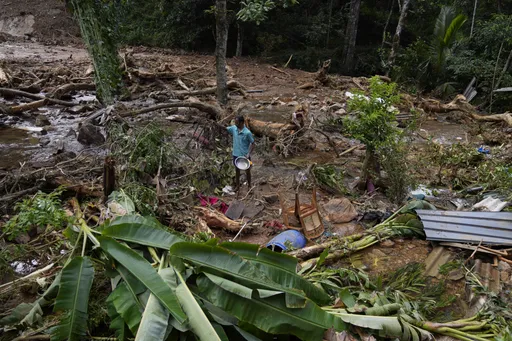California’s largest wildfire has leveled much of the downtown and some surrounding homes in a small Northern California mountain community.
The Dixie Fire tore through Greenville on Wednesday evening, destroying businesses and homes as the sky was cast in an orange glow.
Witnesses described seeing a gas station, hotel and bar burned to the ground.
READ MORE: Massive wildfires in US West send haze of smoke across East Coast
'You must leave now'
“If you are still in the Greenville area, you are in imminent danger and you MUST leave now!!” the Plumas County Sheriff’s Office posted on Facebook earlier Wednesday.
The sheriff's department and Cal Fire did not immediately respond to messages.
The 3-week-old fire has grown to over1,108 square kilometers across Plumas and Butte counties.
Firefighters had been trying to protect the town of 800 about 450 kilometers northeast of San Francisco by clearing debris from roads and marking hazards.
Pandora Valle, a spokesperson with the US Forest Service, earlier told The San Francisco Chronicle that “firefighters are fighting for the town of Greenville,” but could not provide further details about the damage.
The destruction came amid a red flag warning issued by forecasters warning of hot, bone-dry conditions with winds up to 64 km/h.
That could drive flames through timber, brush and grass, especially along the northern and northeastern sides of the vast Dixie Fire.
“I think we definitely have a few hard days ahead of us," said Shannon Prather with the US Forest Service.
Firefighters were able to save homes and hold large stretches of the blaze.
But flames jumped perimeter lines in a few spots Tuesday, prompting additional evacuation orders for about 15,000 people east of Lake Almanor, fire officials said.
READ MORE: Thousands evacuate as wildfires rage across southern Europe
The heat from the flames created a pyrocumulus cloud, a massive column of smoke that rose10,000 yards in the air, said Mike Wink, a state fire operations section chief.
The fire has threatened thousands of homes and destroyed 67 houses and other buildings since breaking out July 14. It was 35% contained.
About 240 kilometers to the west, the lightning-sparked McFarland Fire threatened remote homes along the Trinity River in the Shasta-Trinity National Forest. The fire was only 5% contained. It had burned fiercely through nearly 65 square kilometers of drought-stricken vegetation.
Similar risky weather was expected across Southern California, where heat advisories and warnings were issued for interior valleys, mountains, and deserts for much of the week.
Nearly 100 large fires across the US
Heatwaves and historic drought tied to climate change have made wildfires harder to fight in the American West. Scientists say climate change has made the region much warmer and drier in the past 30 years and will continue to make weather more extreme and wildfires more frequent and destructive.
More than 20,000 firefighters and support personnel were battling 97 large, active wildfires covering 7,560 square kilometers in 13 US states, the National Interagency Fire Center said.
Montana on Tuesday had 25 active large blazes, followed by Idaho with 21 and Oregon with 13. California had 11.
In Hawaii, firefighters gained control over the 160-square-kilometer Mana Road Fire that forced thousands of people to evacuate over the weekend and destroyed at least two homes on the Big Island.
Oregon’s Bootleg Fire, the nation’s largest at 1,676 square kilometers, was 84% contained. Firefighters were busy mopping up hot spots and strengthening fire lines.
“Crews are working tirelessly to ensure we are as prepared as we can be for the extreme fire weather forecast for the next couple days," a US Forest Service update said.
READ MORE: Greece 'waging battle of titans' as flames destroy 150 homes
























